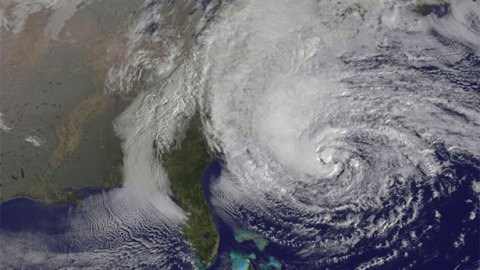The Special Mission of Universities in a Post Sandy World

On Sunday at 7pm EST PBS Nova is airing a special on the science of mega-storm Sandy. For readers who work and teach at universities, I encourage you to watch the program or to check it out online, since the program is likely to offer a valuable context for the special role that universities need to play in a post Sandy era.
Though a single event like Sandy can’t be directly attributed to climate change, the implications of the event are transformative, since the storm has introduced a unique set of new unknowns. As researchers and educators, these risks not only have strong meaning for our lives, that of our children, and of our students, but also for how universities can respond via interdisciplinary programs.
I attended a presentation two weeks ago by Dan Schrag who heads up Harvard’s Center for the Environment. As he described, before Sandy, few scientists were considering how an ice-free Arctic passage might create unusual jet stream patterns that might increase the tendency for Atlantic storms like Sandy to turn inward towards East coast population centers rather than the usual route out to the Atlantic.
But now scientists are studying intensively the possibility that landfall for storms like Sandy on the East coast might be a much more frequent event. If the “new normal” is a hurricane or tropical storm threatening the 65 million people living from Charlotte to Boston on a timescale of years rather than every few decades, the threat introduces the need to significantly re-engineer cities, fundamentally alter our energy grid and transportation system, and to engage the affected local publics on a scale much bigger than even Boston’s decade-long and notorious “Big dig.”
These urban areas and high density population centers will need journalism and communication initiatives that enable people to plan, prepare, connect, participate, and collaborate on re-making their cities into more resilient, safer, durable, and fundamentally different places.
They will need policy experts and scientists who can provide advice on managing risks and on assessing damage. And they will need experts from the humanities and creative professions who can provide the meaning and the motivation to re-examine assumptions, question routines and conventional thinking, and to re-assess priorities.
These dynamics will also create new types of jobs for our students, new opportunities for civic participation, new issues of professional ethics and social responsibility, and new industries and business sectors.
In posts at Age of Engagement, at columns at The Public Square, and elsewhere, I will be writing about the unique role that universities should play in helping our communities and country respond, and in recruiting and engaging students on central challenges that they will face across their adult lives.
These challenges will also be a central focus of the seminar in Sustainability Communication that I am teaching in the Spring, with contributions from students appearing at Age of Engagement.
PBS NOVA: Inside the Megastorm
http://www.pbs.org/wgbh/nova/earth/inside-the-megastorm.html




